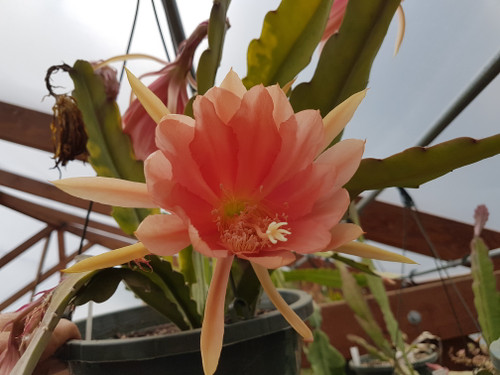Pot Size: 3.5"
Accepted Scientific Name: Epiphyllum 'Gulner's Bride'
Origin and Habitat:
Epiphyllum hybrids are derived from epiphytic cacti native to Central and South America, where they naturally inhabit tropical forests. These plants grow attached to trees or rocks, receiving nutrients from decomposed organic matter and moisture from humid air and rainfall. Their natural environment provides consistent warmth, filtered sunlight, and excellent air circulation. The hybrid ‘Gulner's Bride’ is bred for ornamental cultivation, continuing the legacy of creating stunning Epiphyllum varieties prized for their extravagant floral displays and popularity in collections worldwide.
Description:
Epiphyllum 'Gulner's Bride' produces arching, flat green stems reaching 18–24 inches in length, forming an elegant cascading habit. Its flowers are spectacular, averaging 7–9 inches in diameter, with broad overlapping petals arranged in a symmetrical starburst. The blooms are a striking pure white with luminous undertones, creating a radiant bridal-like appearance. The large flowers open widely, releasing a delicate fragrance and making this cultivar an exceptional highlight for evening and indoor displays.
Cultivation:
Zone: Suitable for Zones 10–11; must be protected or grown indoors in cooler climates.
Temperature: Thrives between 15–27°C; avoid exposure to temperatures below 5°C.
Growth rate: Moderate, accelerating in warm, humid, and bright conditions.
Soil: Requires a well-draining organic mix with pumice added for aeration and root health.
Watering: Keep evenly moist during active growth and flowering; reduce watering slightly during winter rest.
Fertilizing: Apply a diluted balanced fertilizer every 2–3 weeks in spring and summer.
Light: Prefers bright, indirect light; direct sunlight may cause scorching of the stems.
Pests and diseases: Occasionally affected by mealybugs, scale, aphids, or fungal rot if overwatered or poorly ventilated.
Propagation:
Propagate easily from stem cuttings, allowing sections to callus before planting in a well-draining substrate.








